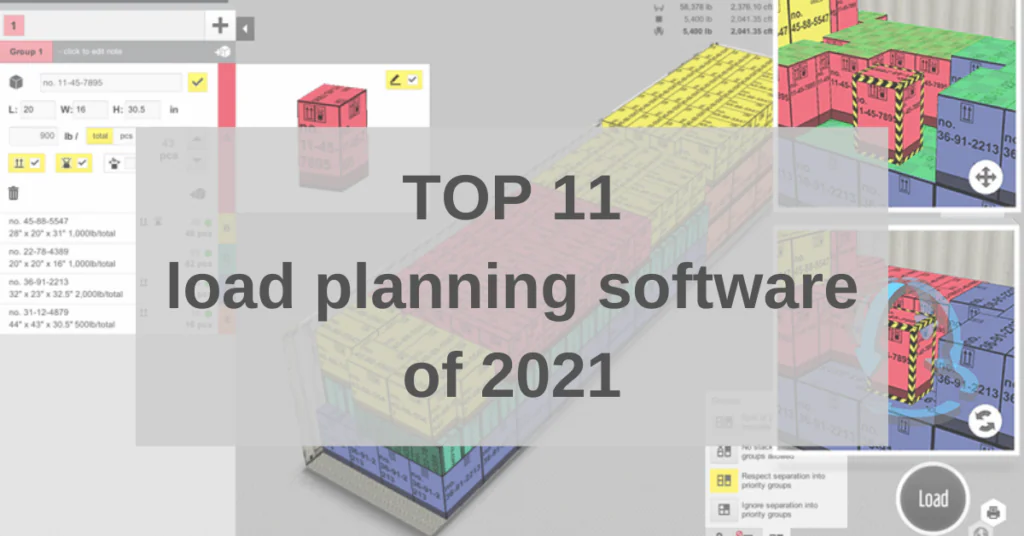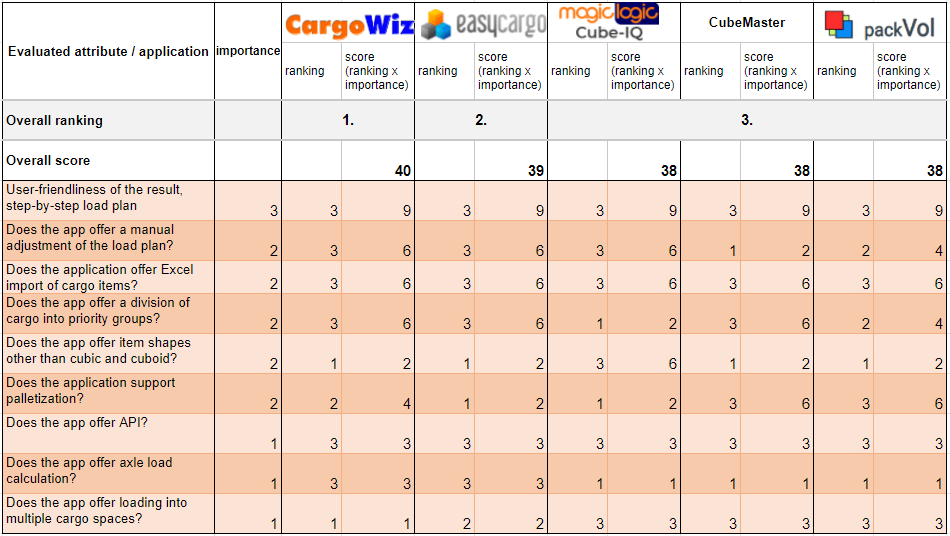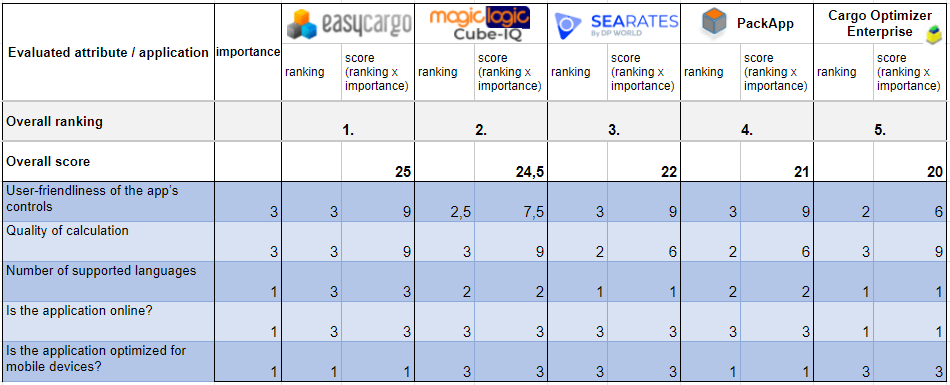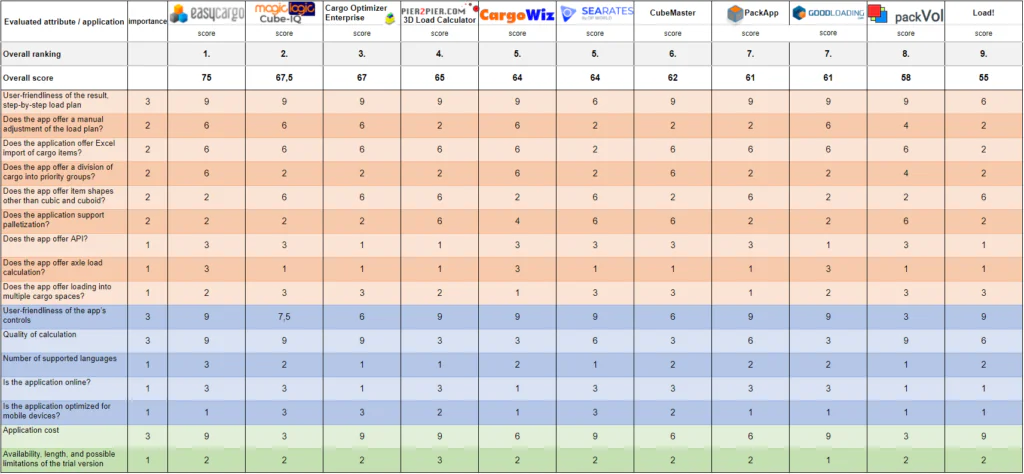Which is the best load planning application? (Part 4/4 – recapitulation, comparison, conclusion)
The information contained in this article is an expression of the views and experiences of its author, obtained by using all the applications listed and gathering the opinions of users of these applications. If you believe any of this information is inaccurate or out of date, we will be happy if you let us know.

In the first part, we discussed the functions that individual load planning applications offer, in the second part, we talked about the experience that awaits the user when using these programs. In the third part, we had a look at the prices of individual software, determined if they have a trial version for free, and if those trial versions have any limitations.
In today’s final part, I will explain the way I evaluated the individual properties of the software, find out how many points applications received for specific criteria, and in the end, I will show you a table where selected applications for loading plannings are sorted by the number of points from best to worst.
The list of all tested applications with links to their websites can be found at the end of this article.
Method of evaluation
For the highest possible level of objectivity, I will detail here the way I compared and then ranked the applications. If you are only interested in the final ranking table, you can skip straight to the final section.
I’ve been thinking for a long time about the best possible way to objectively rank and then compare all the load planning apps. I started by writing down all the features of the programs that I thought should contribute to the overall rating. In doing so, I took into account both my experience using these applications and the feedback and FAQs from our customers. All of these attributes have been discussed in detail in previous parts of this series – these are the sixteen sub-areas:
- Quality of calculation
- Application cost
- User-friendliness of the app’s controls
- User-friendliness of the result, step-by-step load plan
- Does the app offer a manual adjustment of the load plan?
- Does the application offer Excel import of cargo items?
- Does the application offer a division of cargo into so-called priority groups?
- Does the application offer other item shapes other than cubic and cuboid?
- Does the application support palletization?
- Availability, length, and possible limitations of the trial version
- Number of supported languages
- Is the application online?
- Is the application optimized for mobile devices?
- Does the app offer API?
- Does the app offer axle load calculation?
- Does the app offer loading into multiple cargo spaces?
Then, I assigned each attribute an importance rating on a scale from one to three, with one being the least and three being the most important attribute. Again, I drew on the experience and comments of our customers.
In the next step, I scored each of the properties for each application according to how well it met that property. For simplicity and clarity, I always awarded a minimum of one (worst) and a maximum of three (best) points.
In the penultimate step, I multiplied the importance of each feature by the rating of that feature to get the score that the app received for that feature.
To give an example, price is one of the most important features for most customers, so I assigned it the importance of three (highest). As we know from the previous chapter, Cube-IQ is the most expensive of all the applications, so I gave it the worst rating for this feature, a one. The score that Cube-IQ received for the price property is equal to the product of the importance (3) and the rating (1), so 3*1 = 3. I did this for all the attributes and all the software I rated.
score = importance of the feature * rating of the feature
In the last step, for each application, I simply added up all the scores given for all sixteen criteria to get an overall score, which I used to rank the programs from best (highest score) to worst (lowest score).
All of the rated features are also divided into three sections that correspond to the three previous parts in this series. These being: Functions, User Experience, and Pricing and Trial Version.
Result in the Functions section
In the table below, you can see ratings and results for the Functions section. There are nine attributes in this section.
Results in the Functions section. Data current as of February 15, 2020. The complete results table can be found HERE.
The winner of this section is CargoWiz, which has the most required features. It is followed by EasyCargo, which, unlike Cargowiz, does not offer the rather desirable palletization option. In third place with identical overall scores are Cube-IQ, CubeMaster, and packVol.
Cube-IQ lost points for not supporting priority groups, which are essential especially for customers shipping goods from one loading point to multiple customers. On the other hand, it received the highest score for supporting the variety of item shapes it allows to load. CubeMaster lost out on a better position due to the lack of manual load plan adjustments, which combined with the low quality of the calculation can be a major problem. However, it still has many features.
Result in the User Experience section
The following five attributes were included in this section. Since we also discussed the quality of calculation, which undoubtedly affects the user experience, this is also included here.
Results in the User Experience section. Data current as of February 15, 2020. The complete results table can be found HERE.
The winner here is EasyCargo, which scored full points in all categories except for the ability to use the app on mobile devices, which is not yet supported by EasyCargo. Cube-IQ came in second place with a difference of just half a point. Its controls are slightly less intuitive compared to those in EasyCargo and the number of supported languages is half. On the other hand, it is optimized for mobile devices. Searates came in third place. While the user-friendliness is excellent and the app can run on mobile phones as well as tablets, the quality of the calculation is rather average and the only supported language is English.
In fourth place was PackApp, which was similar in its results to Searates, but unlike it, it cannot be run on mobile devices. A small advantage over Searates is the one extra language supported – German. Cargo Optimizer Enterprise rounds out the top five in this category. While it offers high quality of calculation and a dedicated app for both Android and iOS, the user-friendliness is rather average, only English is supported and it is the only one of the five software that is not online and therefore requires installation.
Result in the Pricing and Trial Version section
In the Pricing and Trial Version section, which was the focus of the previous chapter, there are only two features that I evaluated – the price of the application and the availability, length, and possible limitations of the trial version.
Results in the Pricing and Trial version section. Data current as of February 15, 2020. The complete results table can be found HERE.
The winner in this section is 3D Load Calculator, which cannot be rivalled by any other application in this respect, as it is free. Therefore, the length of the trial version is infinite and there are no restrictions.
The second place was then taken by Cargo Optimizer Enterprise, EasyCargo, Load! and Searates.
Total result
The following table combines the three sections we discussed above and the order of the software in this table. This table represents the final ranking of the applications as they stood in this grand comparison.
Overall results with ranking. Data current as of February 15, 2020. To open the table with ranking in Google Sheets, click HERE.
EasyCargo came in first place thanks to its excellent user-friendliness and a reasonable range of required functions. All at a very reasonable price. These positives managed to outweigh the lack of palletization or mobile devices optimization. I may recommend EasyCargo to all those where the quality of calculation, intuitive operation, and low price are important but, also to those who do not need the program to calculate how to load a pallet and only load items in the shape of a cube or block. It is also the best choice for those who want to manually adjust the load plan frequently and want to have the program localized in their language.
The second place belongs to Cube-IQ. Although it is the most expensive of all the applications evaluated, it achieved a high overall score mainly due to its wide range of features and high quality of calculation. This application is suitable for customers who demand high quality of calculation, good user-friendliness or want to use the application on mobile devices. These customers at the same time do not mind the high price, the lack of palletization, the inability to divide the cargo into groups to be unloaded sequentially at different destinations, and the lack of axle load calculation.
Just behind Cube-IQ in third place is Cargo Optimizer Enterprise. It impresses with its calculation quality, great price, support of different item shapes, decent user-friendliness, and having a mobile app for Android and iOS. The drawbacks are the lack of an API for integration with other apps and systems, the lack of priority groups and palletization, and the need for installation – the app is not online.
Fourth place went to 3D Load Calculator. It can be recommended to those who want a free application and do not mind the low quality of the calculation. If you only use a 3D Load Calculator for simple loads, it is a great tool that is very simple to use and will surprise you with its support of palletization or various cargo item shapes. However, for more complex loadings, I would aim for one of the paid programs.
In fifth place was CargoWiz, which may be of interest to some users due to its pricing strategy. Unlike most other apps, there is no annual fee and for the price of $799, you get a lifetime license. If you are willing to tolerate lower quality of calculation, you get a solid tool that is user-friendly, has a nice 3D model, and has most of the important features.
I won’t describe the other six apps in detail here as this article is already very extensive without that and a lot of information can be found in the previous parts of this series of comparison articles. However, this does not mean that these programs are not worth your attention – I believe that each of them will find its satisfied users.
All tables can be viewed at the following links in Excel, Google Sheets, or PDF. Part of the Excel file is a tab Interactive individualized table, where you can change the importance in column D so that the final ranking will be individualized as per your requirements.
If you need help choosing the best load planning application for you or if you want me to help you find out whether or not EasyCargo is the right choice for you, feel free to contact me or book an online meeting with me at this link.
Here are the Top 11 solutions with links to their websites: 3D Load Calculator, CargoWizz, Cargo Optimizer Enterprise, Cube-IQ, CubeMaster, EasyCargo, Goodloading, Load!, PackApp, PackVol, and SeaRates.








